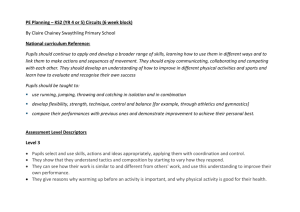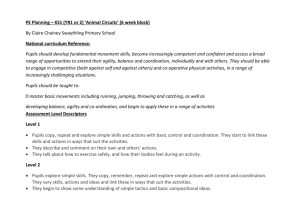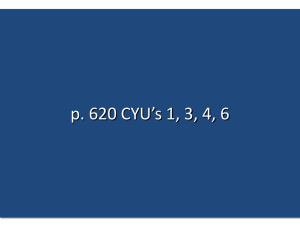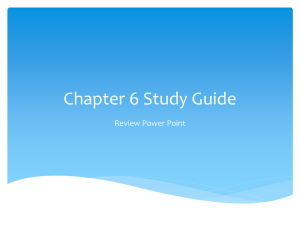Final version of PE curriculum presentation (1)
advertisement
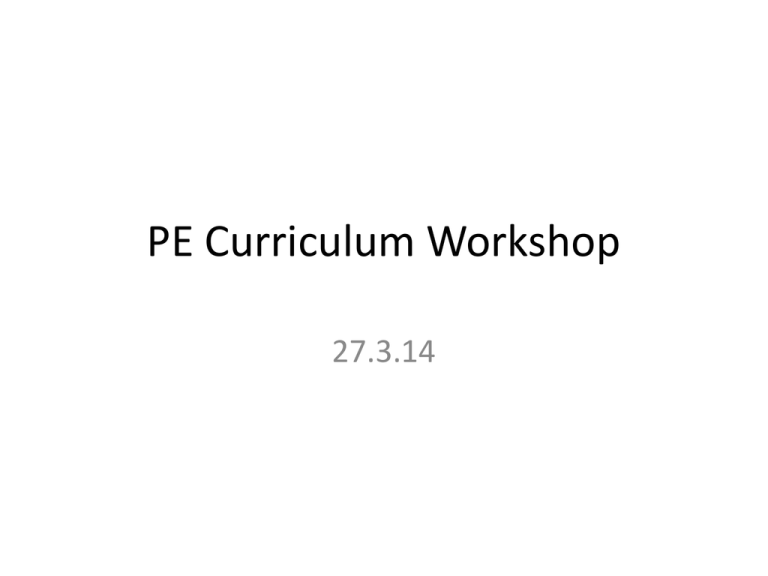
PE Curriculum Workshop 27.3.14 New curriculum (CC) • What’s in what’s out? What’s in: • • • • • • • • • • • All chn to develop competence to excel in a broad range of activities. Be physically active for sustained periods of time. Engage in competitive sports and activities. Lead healthy active lives. KS1 Competitive element. No specific gymnastics reference. KS2 Communicating, collaborating and competing Expectation that the PE curriculum will enable children to become ‘physically confident’ as opposed to just knowing what is happening to their body. Emphasis placed on fairness and respect – sportsmanship What’s out: • • • • No programmes of study Non-statutory requirement of swimming at KS 1 removed – now required to swim in either KS1 or KS2. KS1 - No breadth of study mentioned – it is now motor skills, team games and dance. KS2 –Breadth of study – no specific titles but content refers to athletics, competitive team games, athletics/gym skills, dance performance, OAA (individual and team) and strategies for improving personal bests. New curriculum (CC) KS1 and 2 overviews • • • • • • • • • • • • Pupils should be taught about: (Key Stage One) Pupils should develop fundamental movement skills, become increasingly competent and confident and access a broad range of opportunities to extend their agility, balance and coordination, individually and with others. They should be able to engage in competitive (both against self and against others) and cooperative physical activities, in a range of increasingly challenging situations. Pupils should be taught to: master basic movements including running, jumping, throwing and catching, as well as developing balance, agility and co-ordination, and begin to apply these in a range of activities participate in team games, developing simple tactics for attacking and defending perform dances using simple movement patterns. Pupils should be taught about: (Key Stage two) Pupils should continue to apply and develop a broader range of skills, learning how to use them in different ways and to link them to make actions and sequences of movement. They should enjoy communicating, collaborating and competing with each other. They should develop an understanding of how to improve in different physical activities and sports and learn how to evaluate and recognise their own success. Pupils should be taught to: use running, jumping, throwing and catching in isolation and in combination play competitive games, modified where appropriate and apply basic principles suitable for attacking and defending develop flexibility, strength, technique, control and balance perform dances using a range of movement patterns take part in outdoor and adventurous activity challenges both individually and within a team compare their performances with previous ones and demonstrate improvement to achieve their personal best. Swimming and water safety All schools must provide swimming instruction either in key stage 1 or key stage 2. In particular, pupils should be taught to: swim competently, confidently and proficiently over a distance of at least 25 metres use a range of strokes effectively perform safe self-rescue in different water-based situations. New curriculum (CC) Major changes • Breadth/Programs of study labels removed. • Swimming requirements are now so specific and higher level i.e. 25m, self rescue and a variety of specified strokes competently. • Aims – wide number of teams competing on various levels – intra, inter and wider. • Sustained periods of time of being active within the lessons. Why is PE so important? (TJ) 1. 2. 3. 4. 5. 6. 7. 8. 9. 10. Improved Physical Fitness Skill Development Regular, Healthful Physical Activity Support of Other Subject Areas Self Discipline Improved Judgment Stress Reduction Strengthened Peer Relationships Improved Self-confidence and Self-esteem Experience Setting Goals The Power of 10!!! Fitness Planning (CC) KS1 Session Number 1 2 3 4 5 6 LO Activity LO: To understand what they are capable Warm up: movement to of achieving with their bodies by gaining a music. baseline level of fitness. Main: assessment session. Plenary: putting equipment away safely. LO: To understand the term speed and Warm up: Animal what different activities we can do to movement. make us faster. Main: speed stations. Plenary: re-test cheetah sprint. LO: To understand the term stamina and Warm up: Bean game. what different activities we can do to Main: stamina stations. improve our stamina. Plenary: re-test Hare shuttle runs. LO: To understand the term co-ordination Warm up: Cups and Cones. and what different activities we can do to Main: co-ordination increase our co-ordination. stations. Plenary: re-test Flamingo Fling. LO: To understand the term agility and Warm up: video recorder. what different activities we can do to Main: agility stations. make us more agile. Plenary: re-test Bunny Bench Hops. LO: To investigate whether practise has Warm up: movement to improved our performance. music. Main: final assessment of all stations. Plenary: assessment and results discussions. Resources Resources: stop watches, class record sheet, cones, benches, bean bags, variety of different sized balls. Resources: cones, bean bags, stop watches. Resources: stop watches, bean bags, quoits, mats, cones. Resources: cones, bean bags, buckets, small balls, quoits, hoops, various size balls. Resources: cones, stop watches, hoola hoops, balance beams (low and higher), benches. Resources: stop watches, class record sheet, cones, benches, bean bags, variety of different sized balls. Fitness Planning (CC) KS2 Session Number LO Activity Resources 1 LO: To understand what they are capable of achieving with their bodies by gaining a baseline level of fitness. Resources: stop watches, class record sheet, cones, benches, bean bags, variety of different sized balls, music for aerobics warm up. 2 LO: To understand the different activities we can do to improve speed. 3 LO: To understand the different activities we can do to improve our stamina. 4 LO: To understand the different activities we can do to increase our co-ordination. 5 LO: To understand the different activities we can do to make us more agile. 6 LO: To investigate whether practise has improved our performance. Warm up: Cups and Cones. Main: assessment session. Plenary: putting equipment away safely and prediction discussions. Warm up: Bean Game. Main: speed stations. Plenary: re-test sprint assessment. Warm up: Bleep Test. Main: stamina stations. Plenary: re-test shuttle runs assessment. Warm up: aerobics to music. Main: co-ordination stations. Plenary: re-test target ball assessment. Warm up: aerobics to music. Main: agility stations. Plenary: re-test step ups assessment. Warm up: aerobics to music Main: re-assess children for all fitness stations. Plenary: results discussions. Have we improved? Resources: cones, bean bags, stop watches, skipping ropes. Resources: stop watches, exercise weights, tape measure, mats, cones, Bleep Test. Resources: cones, bean bags, buckets, small balls, quoits, hoops, various size balls. Resources: cones, stop watches, hoola hoops, balance beams (low and higher), benches, mats. Resources: stop watches, class record sheet, cones, benches, bean bags, variety of different sized balls, Target. Basketball Planning. (TJ) KS1 Warm Up: Fundamental skills and Movement Literacy. What is Movement Literacy? ‘The identification and understanding of the building blocks of movement’. ‘The build up of core FUNdamental skills that go into the make up of any specific movement’. All movements are made up of basic FUNdamental ‘skills’ or actions. These skills are the basis for learning more difficult practises later on. Session Structure: Ball Familiarisation - Game – Skill – Game – Cool Down (pg. 7) Ball Familiarisation and skills: To master basic movements including throwing and catching. Games: Enter the Jungle and Islands (pg. 7) Competition: (Big push!) To apply skills within game situations, develop tactics for attacking and defending and improving on their own performance on a weekly basis e.g. Bade of honour. KS2 Warm Up: FUNdamental skills and familiarisation skills (developing the basics to build upon). Lesson Structure: Fundamental Skill > Ball Familiarisation> Game > Skill > Game > Cool Down Session 2 example: SAQ drills > Ball Familiarisation Skills > Skill – Passing > Game – ‘Piggy in the Middle’ 3 Vs. 1 and 4 Vs. 4 game (Pg. 11 – 13) Competition Increased Competition – personal and team. Evaluation and Recommendations Evaluate performance and make recommendations for improvement. No more ‘Study Labels’ You do not have to teach to specific ‘Study Labels’. Therefore, Basketball could be combined with Volleyball and Benchball for example. Other considerations for successful Planning and Teaching of PE (TJ) Teaching Outstanding PE Lessons using the New Ofsted Criteria: • Planning (Clear Learning Objectives and Differentiated) • PMA – Positive Mental Attitude • Warm Ups – Effective (Getting them ready for the activity they are going to do). • Pace – Cut away, lines and grids for smooth transitions and time trials for success • Progress – is everybody being challenged? • Games and competition- Applying learning to a real life context – ‘game like context’ • Assessment - Assessing and Intervening to have notable impact (Improve and Evaluate one of the 4 strands of PE). • Time - Choose words carefully! (Children must be active for 80% of the lesson). • Finish strongly – children to demonstrate what they have learnt and celebrate the achievements of individuals or groups of pupils. • Evaluate – what needs to be recapped, did the level of challenge meet every child’s ability level and based on your reflections, what are the implications for the next session. • Pupil voice – what sports or activities do the children want to learn? Competition – The ‘New’ focus! (TJ) Competition has a stronger focus in PE. National Governing Bodies of Sport have created new sports formats for intra and inter-school competition to encourage all young people to participate. TO INSPIRE EVERY PUPIL. Level 1: Intra School Competition Creating competition in every school with every lesson. The intra-school competition formats for primary schools are designed as competitive challenges leading to a recognisable competition in that sport, helping pupils to learn the skills of the game – and how to win and lose. Examples: Class Vs. Class, House Vs. House and Own Events (Lunchtime or Afterschool). Can the competitions be organised, run and officiated by pupils with adult supervision? Level 2: School Sport Tournament / League More competition between schools at district level. Level 3: School Sports Festivals A competition showcase for each county’s schools. Level 4: School Sport National Games Annual High Profile National Event. Money (CC) • How are you spending yours? Has your school bought in to a scheme e.g. Julia’s from Solent or are you spending it yourself? If you are spending it yourself as a school, is your head just spending it on PPA cover? This is not really what it is intended for. You need to look to using it for CPD opportunities for your staff, equipment for your children etc. • OFSTED want to know! My school had OFSTED last week and I was interviewed by an inspector as to how our PE funding was being spent. She wanted to know if I thought I had got my school good value for money, exactly how much my school had received etc. I was able to have the excel printout to hand (as well as my own scribblings) and talk her through exactly where my money was going and where I would like it to go in the future. I was also able to talk about the fact that it had had a big impact on our pupil premium children’s attendance to after school clubs i.e. all in R – 4 have been to multi-skills so far this year. If you don’t know already, you need to know! Questions? • Any questions?




